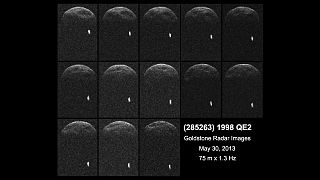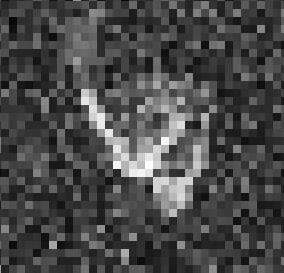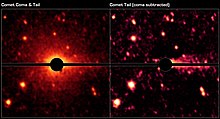
2062 Aten, provisional designation 1976 AA, is a stony sub-kilometer asteroid and namesake of the Aten asteroids, a subgroup of near-Earth objects. The asteroid was named after Aten from Egyptian mythology.
1866 Sisyphus is a binary stony asteroid, near-Earth object and the largest member of the Apollo group, approximately 7 kilometers in diameter.
2059 Baboquivari, provisional designation 1963 UA, is an asteroid classified as near-Earth object of the Amor group, approximately 1.9 kilometers in diameter. Discovered by the Indiana Asteroid Program in 1963, it was later named after the Baboquivari Mountains in Arizona, United States.

4954 Eric is an eccentric, stony asteroid, classified as near-Earth object of the Amor group, approximately 11 kilometers in diameter. It was discovered by American astronomer Brian Roman at Palomar Observatory on 23 September 1990. The asteroid was named after its discoverer's son, Eric Roman.

(480808) 1994 XL1 is a sub-kilometer asteroid, classified as near-Earth object and potentially hazardous asteroid of the Aten group, approximately 200 meters (700 feet) in diameter. It was discovered on 6 December 1994, by Scottish–Australian astronomer Robert McNaught at Siding Spring Observatory in Australia. It was one of the first asteroids discovered to have a semi-major axis less than Venus.
14827 Hypnos is a highly eccentric, sub-kilometer-sized carbonaceous asteroid that is thought to be an extinct comet. It is classified as near-Earth object and potentially hazardous asteroid of the Apollo group.
3192 A'Hearn, provisional designation 1982 BY1, is a carbonaceous asteroid from the inner regions of the asteroid belt, about 6 kilometers in diameter. It was discovered by American astronomer Edward Bowell at Lowell's Anderson Mesa Station in Flagstaff, Arizona, on 30 January 1982.
8034 Akka, provisional designation 1992 LR, is a sub-kilometer sized, eccentric asteroid and near-Earth object of the Apollo group, approximately 540 meters in diameter. It was discovered at Palomar Observatory in 1992, and named after Akka from Finnish mythology.
2061 Anza, provisional designation 1960 UA, is an eccentric asteroid of the Amor group, a subtype of near-Earth objects, estimated to measure approximately 2.7 kilometers in diameter. It was discovered on 22 October 1960, by American astronomer Henry Giclas at Lowell's Flagstaff Observatory in Arizona, United States. The asteroid was later named after Spanish explorer Juan Bautista de Anza.
2608 Seneca, provisional designation 1978 DA, is a stony asteroid and sub-kilometer near-Earth object of the Amor group, approximately 0.9 kilometers in diameter. It was discovered on 17 February 1978, by German astronomer Hans-Emil Schuster at ESO's La Silla Observatory in northern Chile, and named after Roman philosopher Seneca.
5370 Taranis, provisional designation 1986 RA, is an asteroid and suspected dormant comet on an eccentric orbit, classified as near-Earth object of the Amor group, approximately 5 kilometers in diameter.
(6491) 1991 OA is a highly eccentric, stony asteroid, classified as near-Earth object and potentially hazardous asteroid, approximately half a kilometer in diameter. It was discovered on 16 July 1991, by American astronomer Henry E. Holt at the U.S. Palomar Observatory in California.
(467336) 2002 LT38, is a sub-kilometer asteroid and suspected tumbler, classified as a near-Earth object and potentially hazardous asteroid of the Aten group, approximately 240 meters (790 ft) in diameter. It was discovered on 12 June 2002, by astronomers of the Lincoln Near-Earth Asteroid Research at the Lincoln Laboratory's Experimental Test Site near Socorro, New Mexico, in the United States.
(471240) 2011 BT15, provisional designation 2011 BT15, is a stony, sub-kilometer sized asteroid and fast rotator, classified as a near-Earth object and potentially hazardous asteroid of the Apollo group. It had been one of the objects with the highest impact threat on the Palermo Technical Impact Hazard Scale.

(285263) 1998 QE2, provisional designation 1998 QE2, is a dark asteroid and synchronous binary system, classified as near-Earth object and potentially hazardous asteroid of the Amor group, approximately 3 kilometers in diameter. It was discovered on 19 August 1998, by astronomers of the LINEAR program at Lincoln Laboratory's Experimental Test Site near Socorro, New Mexico, in the United States. Its sub-kilometer minor-planet moon was discovered by radar on 30 May 2013.

(192642) 1999 RD32, provisional designation: 1999 RD32, is an asteroid and suspected contact binary on an eccentric orbit, classified as a large near-Earth object and potentially hazardous asteroid of the Apollo group, approximately 5 kilometers (3 miles) in diameter. It was discovered on 8 September 1999, at a magnitude of 18, by astronomers of the LINEAR program using its 1-meter telescope at the Lincoln Laboratory's Experimental Test Site near Socorro, New Mexico, United States. The asteroid is likely of carbonaceous composition and has a rotation period of 17.08 hours.
(374158) 2004 UL is a sub-kilometer asteroid on an outstandingly eccentric orbit, classified as near-Earth object and potentially hazardous asteroid of the Apollo group. The object is known for having the second-smallest perihelion of any known asteroid, after (137924) 2000 BD19.

1996 PW is an exceptionally eccentric trans-Neptunian object and damocloid on an orbit typical of long-period comets but one that showed no sign of cometary activity around the time it was discovered. The unusual object measures approximately 10 kilometers in diameter and has a rotation period of 35.4 hours and likely an elongated shape.

(300163) 2006 VW139, provisional designations 2006 VW139 and P/2006 VW139, as well as periodic cometary number 288P, is a kilometer-sized asteroid from the outer regions of the asteroid belt and the first "binary main-belt comet" ever discovered.
(457175) 2008 GO98, provisional designation 2008 GO98 with cometary number 362P, is a Jupiter family comet in a quasi-Hilda orbit within the outermost regions of the asteroid belt. It was discovered on 8 April 2008, by astronomers of the Spacewatch program at Kitt Peak National Observatory near Tucson, Arizona, in the United States. This presumably carbonaceous body has a diameter of approximately 15 kilometers (9 miles) and rotation period of 10.7 hours.








